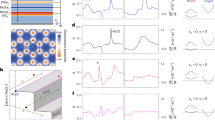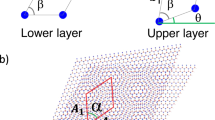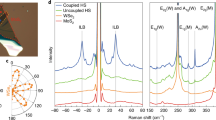Abstract
The unique physics in moiré superlattices of twisted or lattice-mismatched atomic layers holds great promise for future quantum technologies. However, twisted configurations are thermodynamically unfavourable, making accurate twist angle control during growth implausible. While rotationally aligned, lattice-mismatched moirés such as WSe2/WS2 can be synthesized, they lack the critical moiré period tunability, and their formation mechanisms are not well understood. Here, we report the thermodynamically driven van der Waals epitaxy of moirés with a tunable period from 10 to 45 nanometres, using lattice mismatch engineering in two WSSe layers with adjustable chalcogen ratios. Contrary to conventional epitaxy, where lattice-mismatch-induced stress hinders high-quality growth, we reveal the key role of bulk stress in moiré formation and its unique interplay with edge stress in shaping the moiré growth modes. Moreover, the superlattices display tunable interlayer excitons and moiré intralayer excitons. Our studies unveil the epitaxial science of moiré synthesis and lay the foundations for moiré-based technologies.
This is a preview of subscription content, access via your institution
Access options
Access Nature and 54 other Nature Portfolio journals
Get Nature+, our best-value online-access subscription
$29.99 / 30 days
cancel any time
Subscribe to this journal
Receive 12 print issues and online access
$259.00 per year
only $21.58 per issue
Buy this article
- Purchase on Springer Link
- Instant access to full article PDF
Prices may be subject to local taxes which are calculated during checkout





Similar content being viewed by others
Data availability
Source data are provided with this paper. Other supporting data and very large files are available from the corresponding authors upon reasonable request.
Code availability
The codes that support the findings of this study are available from the corresponding authors upon reasonable request.
References
Rong, Z. Y. & Kuiper, P. Electronic effects in scanning tunneling microscopy: moiré pattern on a graphite surface. Phys. Rev. B 48, 17427–17431 (1993).
Bistritzer, R. & MacDonald, A. H. Moiré bands in twisted double-layer graphene. Proc. Natl Acad. Sci. USA 108, 12233–12237 (2011).
Kim, K. et al. Van der Waals heterostructures with high accuracy rotational alignment. Nano Lett. 16, 1989–1995 (2016).
Kim, K. et al. Tunable moiré bands and strong correlations in small-twist-angle bilayer graphene. Proc. Natl Acad. Sci. USA 114, 3364–3369 (2017).
Alexeev, E. M. et al. Resonantly hybridized excitons in moiré superlattices in van der Waals heterostructures. Nature 567, 81–86 (2019).
Jin, C. et al. Observation of moiré excitons in WSe2/WS2 heterostructure superlattices. Nature 567, 76 (2019).
Seyler, K. L. et al. Signatures of moiré-trapped valley excitons in MoSe2/WSe2 heterobilayers. Nature 567, 66 (2019).
Tran, K. et al. Evidence for moiré excitons in van der Waals heterostructures. Nature 567, 71 (2019).
Yu, H., Liu, G.-B., Tang, J., Xu, X. & Yao, W. Moiré excitons: from programmable quantum emitter arrays to spin-orbit–coupled artificial lattices. Sci. Adv. 3, e1701696 (2017).
Zhang, N. et al. Moiré intralayer excitons in a MoSe2/MoS2 heterostructure. Nano Lett. 18, 7651–7657 (2018).
Cao, Y. et al. Correlated insulator behaviour at half-filling in magic-angle graphene superlattices. Nature 556, 80–84 (2018).
Cao, Y. et al. Unconventional superconductivity in magic-angle graphene superlattices. Nature 556, 43–50 (2018).
Yankowitz, M. et al. Tuning superconductivity in twisted bilayer graphene. Science 363, 1059–1064 (2019).
Sharpe, A. L. et al. Emergent ferromagnetism near three-quarters filling in twisted bilayer graphene. Science 365, 605–608 (2019).
Kennes, D. M. et al. Moiré heterostructures as a condensed-matter quantum simulator. Nat. Phys. 17, 155–163 (2021).
Ma, C. et al. Intelligent infrared sensing enabled by tunable moiré quantum geometry. Nature 604, 266–272 (2022).
Mak, K. F. & Shan, J. Semiconductor moiré materials. Nat. Nanotechnol. 17, 686–695 (2022).
Lee, J.-H. et al. Wafer-scale growth of single-crystal monolayer graphene on reusable hydrogen-terminated germanium. Science 344, 286–289 (2014).
Ahn, S. J. et al. Dirac electrons in a dodecagonal graphene quasicrystal. Science 361, 782–786 (2018).
Sun, L. et al. Hetero-site nucleation for growing twisted bilayer graphene with a wide range of twist angles. Nat. Commun. 12, 2391 (2021).
Liu, C. et al. Designed growth of large bilayer graphene with arbitrary twist angles. Nat. Mater. 21, 1263–1268 (2022).
Yang, W. et al. Epitaxial growth of single-domain graphene on hexagonal boron nitride. Nat. Mater. 12, 792–797 (2013).
Lin, Y.-C. et al. Atomically thin resonant tunnel diodes built from synthetic van der Waals heterostructures. Nat. Commun. 6, 7311 (2015).
Li, B. et al. Direct vapor phase growth and optoelectronic application of large band offset SnS2/MoS2 vertical bilayer heterostructures with high lattice mismatch. Adv. Electron. Mater. 2, 1600298 (2016).
Li, X. et al. Two-dimensional GaSe/MoSe2 misfit bilayer heterojunctions by van der Waals epitaxy. Sci. Adv. 2, e1501882 (2016).
Fu, D. et al. Molecular beam epitaxy of highly crystalline monolayer molybdenum disulfide on hexagonal boron nitride. J. Am. Chem. Soc. 139, 9392–9400 (2017).
Yang, T. et al. Van der Waals epitaxial growth and optoelectronics of large-scale WSe2/SnS2 vertical bilayer p–n junctions. Nat. Commun. 8, 1906 (2017).
Carozo, V. et al. Excitonic processes in atomically-thin MoSe2/MoS2 vertical heterostructures. 2D Mater. 5, 031016 (2018).
Fu, Q. et al. One-step synthesis of metal/semiconductor heterostructure NbS2/MoS2. Chem. Mater. 30, 4001–4007 (2018).
Wu, R. et al. Van der Waals epitaxial growth of atomically thin 2D metals on dangling-bond-free WSe2 and WS2. Adv. Funct. Mater. 29, 1806611 (2019).
Wu, X. et al. Vapor growth of WSe2/WS2 heterostructures with stacking dependent optical properties. Nano Res. 12, 3123–3128 (2019).
Zheng, W. et al. Direct vapor growth of 2D vertical heterostructures with tunable band alignments and interfacial charge transfer behaviors. Adv. Sci. 6, 1802204 (2019).
Li, J. et al. General synthesis of two-dimensional van der Waals heterostructure arrays. Nature 579, 368–374 (2020).
Li, B. et al. Van der Waals epitaxial growth of air-stable CrSe2 nanosheets with thickness-tunable magnetic order. Nat. Mater. 20, 818–825 (2021).
Chen, L. et al. Step-edge-guided nucleation and growth of aligned WSe2 on sapphire via a layer-over-layer growth mode. ACS Nano 9, 8368–8375 (2015).
Zhang, X. et al. Defect-controlled nucleation and orientation of WSe2 on hBN: a route to single-crystal epitaxial monolayers. ACS Nano 13, 3341–3352 (2019).
Chubarov, M. et al. Wafer-scale epitaxial growth of unidirectional WS2 monolayers on sapphire. ACS Nano 15, 2532–2541 (2021).
Wang, J. et al. Dual-coupling-guided epitaxial growth of wafer-scale single-crystal WS2 monolayer on vicinal a-plane sapphire. Nat. Nanotechnol. 17, 33–38 (2022).
Liu, L. et al. Uniform nucleation and epitaxy of bilayer molybdenum disulfide on sapphire. Nature 605, 69–75 (2022).
Deng, J., Fampiou, I., Liu, J. Z., Ramasubramaniam, A. & Medhekar, N. V. Edge stresses of non-stoichiometric edges in two-dimensional crystals. Appl. Phys. Lett. 100, 251906 (2012).
Liu, J. et al. Interpretable molecular models for molybdenum disulfide and insight into selective peptide recognition. Chem. Sci. 11, 8708–8722 (2020).
Fortin-Deschênes, M. et al. Dynamics of antimonene–graphene van der Waals growth. Adv. Mater. 31, 1900569 (2019).
Coraux, J. et al. Growth of graphene on Ir(111). New J. Phys. 11, 023006 (2009).
Tetlow, H. et al. Growth of epitaxial graphene: theory and experiment. Phys. Rep. 542, 195–295 (2014).
Levita, G., Molinari, E., Polcar, T. & Righi, M. C. First-principles comparative study on the interlayer adhesion and shear strength of transition-metal dichalcogenides and graphene. Phys. Rev. B 92, 085434 (2015).
Amani, M. et al. Growth-substrate induced performance degradation in chemically synthesized monolayer MoS2 field effect transistors. Appl. Phys. Lett. 104, 203506 (2014).
Liu, Z. et al. Strain and structure heterogeneity in MoS2 atomic layers grown by chemical vapour deposition. Nat. Commun. 5, 5246 (2014).
Chae, W. H., Cain, J. D., Hanson, E. D., Murthy, A. A. & Dravid, V. P. Substrate-induced strain and charge doping in CVD-grown monolayer MoS2. Appl. Phys. Lett. 111, 143106 (2017).
Ajayi, O. A. et al. Approaching the intrinsic photoluminescence linewidth in transition metal dichalcogenide monolayers. 2D Mater. 4, 031011 (2017).
Hong, X. et al. Ultrafast charge transfer in atomically thin MoS2/WS2 heterostructures. Nat. Nanotechnol. 9, 682–686 (2014).
Kang, J., Tongay, S., Zhou, J., Li, J. & Wu, J. Band offsets and heterostructures of two-dimensional semiconductors. Appl. Phys. Lett. 102, 012111 (2013).
Zhou, S., Ning, J., Sun, J. & Srolovitz, D. J. Composition-induced type I and direct bandgap transition metal dichalcogenides alloy vertical heterojunctions. Nanoscale 12, 201–209 (2020).
Duan, X. et al. Synthesis of WS2xSe2–2x alloy nanosheets with composition-tunable electronic properties. Nano Lett. 16, 264–269 (2016).
Fortin-Deschênes, M. et al. 2D antimony–arsenic alloys. Small 16, 1906540 (2020).
Kezilebieke, S. et al. Electronic and magnetic characterization of epitaxial CrBr3 monolayers on a superconducting substrate. Adv. Mater. 33, 2006850 (2021).
Gao, Z.-Y. et al. Experimental realization of atomic monolayer Si9C15. Adv. Mater. 34, 2204779 (2022).
Vogt, P. et al. Silicene: compelling experimental evidence for graphenelike two-dimensional silicon. Phys. Rev. Lett. 108, 155501 (2012).
Weston, A. et al. Atomic reconstruction in twisted bilayers of transition metal dichalcogenides. Nat. Nanotechnol. 15, 592–597 (2020).
Li, S. et al. Halide-assisted atmospheric pressure growth of large WSe2 and WS2 monolayer crystals. Appl. Mater. Today 1, 60–66 (2015).
Ma, D. et al. A universal etching-free transfer of MoS2 films for applications in photodetectors. Nano Res. 8, 3662–3672 (2015).
Rangel DaCosta, L. et al. Prismatic 2.0 – simulation software for scanning and high resolution transmission electron microscopy (STEM and HRTEM). Micron 151, 103141 (2021).
Rosenberger, M. R. et al. Nano-“squeegee” for the creation of clean 2D material interfaces. ACS Appl. Mater. Interfaces 10, 10379–10387 (2018).
Acknowledgements
STEM images were collected by A. Penn. M.F.-D. acknowledges support from the Natural Sciences and Engineering Research Council of Canada (NSERC) and Fonds de Recherche du Québec (FRQNT). M.F.-D. and F.X. acknowledge the partial support from the Government of Israel and Yale University. K.W. and T.T. acknowledge support from Japan Society for the Promotion of Science KAKENHI (grant nos 19H05790, 20H00354 and 21H05233).
Author information
Authors and Affiliations
Contributions
M.F.-D. conceived and carried out the experiments and simulations. M.F.-D. and F.X. analysed the results and wrote the manuscript. K.W. and T.T. synthesized the hBN crystals.
Corresponding authors
Ethics declarations
Competing interests
The authors declare no competing interests.
Peer review
Peer review information
Nature Materials thanks Lain-Jong Li, David Geohegan and the other, anonymous, reviewer(s) for their contribution to the peer review of this work.
Additional information
Publisher’s note Springer Nature remains neutral with regard to jurisdictional claims in published maps and institutional affiliations.
Supplementary information
Supplementary Information
Supplementary Figs. 1–17 and Discussion.
Source data
Source Data Fig. 2
Plot of moiré lattice parameter versus ΔSe.
Source Data Fig. 3
Simulation results.
Source Data Fig. 4
Histograms.
Source Data Fig. 5
PL data.
Rights and permissions
Springer Nature or its licensor (e.g. a society or other partner) holds exclusive rights to this article under a publishing agreement with the author(s) or other rightsholder(s); author self-archiving of the accepted manuscript version of this article is solely governed by the terms of such publishing agreement and applicable law.
About this article
Cite this article
Fortin-Deschênes, M., Watanabe, K., Taniguchi, T. et al. Van der Waals epitaxy of tunable moirés enabled by alloying. Nat. Mater. 23, 339–346 (2024). https://doi.org/10.1038/s41563-023-01596-z
Received:
Accepted:
Published:
Issue Date:
DOI: https://doi.org/10.1038/s41563-023-01596-z
This article is cited by
-
Growing tunable moiré matter
Nature Materials (2024)



